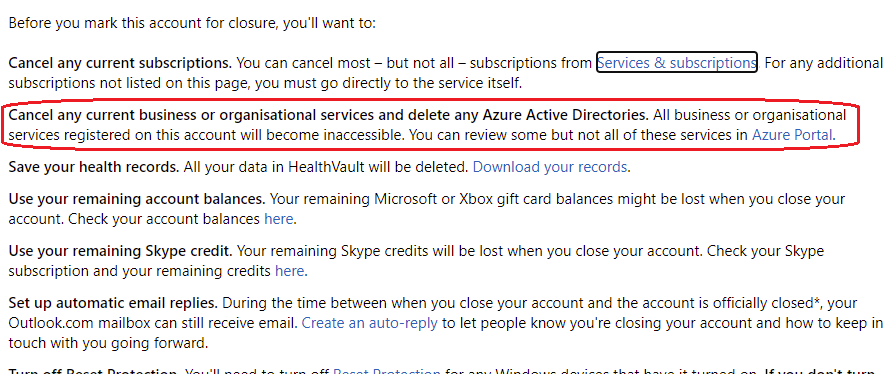Hello @Michael Brooks ,
I am sorry that you have to face this difficulty because of two accounts. I understand it can be quite annoying sometimes. Lets me try to clarify few points and answer your queries with possible explanations as per best of my knowledge. these warnings are general warnings for any user which they see when deleting their Microsoft account.
You mention that you have work email address which is used for both azure AD and Microsoft Account. Let me assume that you If you have a azure AD account with a user@keyman .com then your azure AD has domain.com setup as verified domain within the tenant and this account was created first and you signed up using this work email account as a Microsoft account later. You are totally correct that they are both separate accounts and have been created and exist in two different identity systems.
The section services and subscriptions covers any Windows licenses, Office license , O365 personal subscription, XboxLive account etc. that you may have purchased using this Microsoft Account . I am assuming that you may not have but I would still like you to follow the link and verify that .
Let me add some information about the section "cancel any current business or organizational services and delete any Azure Active Directories" This warning is there because in initial days of azure people used to sign up for azure using Microsoft Account and their azure subscription would get created in the background with the Microsoft account being the account admin on this Azure subscription . Since an azure subscription can not exist without an azure Active directory instance so an AAD instance was also automatically created. So if you signed up for azure using user{at}hotmail.com then your directory would automatically be named userhotmail.onmicrosoft.com with which your new subscription would be associated. And the Microsoft account user{at}hotmail.com would be added as an global administrator in the directory .
So this is to prevent any such scenario where the Microsoft account could be only global admin of any directory and there is no second global admin in which case users used to lock themselves out of the azure AD tenant. Users would have access but no administrative operation could be done on the tenant . Hence this is provided as an option there. I would suggest to remove the Microsoft account from any azure AD wherever it might be added as a Global admin. This may not be necessary though.
I think you can go ahead with deleting the account if you do not have any such issues. Hope the above provided clarifications you were looking for. In case I still missed anything , please do let me know in comments and we will be happy to help you further on this. Should this answer be helpful , please do accept the post as answer which will help others in the community who may have similar queries.
Thank you.
